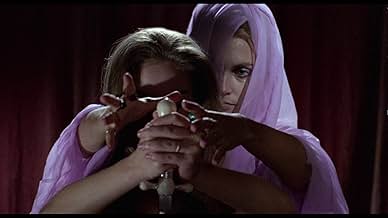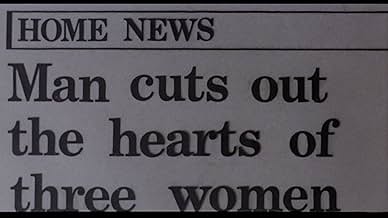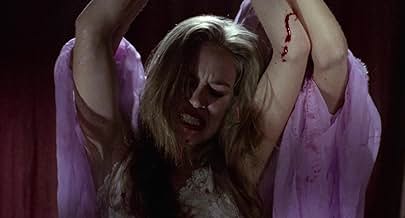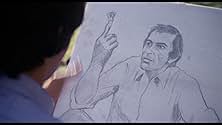IMDb-BEWERTUNG
6,2/10
2615
IHRE BEWERTUNG
Die frisch verheiratete Susan wird von Visionen von Mircalla Karnstein heimgesucht, einer jahrhundertealten Braut, die ihren Mann in der Hochzeitsnacht ermordet hat.Die frisch verheiratete Susan wird von Visionen von Mircalla Karnstein heimgesucht, einer jahrhundertealten Braut, die ihren Mann in der Hochzeitsnacht ermordet hat.Die frisch verheiratete Susan wird von Visionen von Mircalla Karnstein heimgesucht, einer jahrhundertealten Braut, die ihren Mann in der Hochzeitsnacht ermordet hat.
- Regie
- Drehbuch
- Hauptbesetzung
- Auszeichnungen
- 1 wins total
Empfohlene Bewertungen
There have been no less than FIVE classic European horror films based on the Sheridan LeFanu classic story "Carmilla". There was the creepy, expressionistic Carl Theodore Dryer film "Vampyr" back in the 30's. There was the famous Hammer period horror film "The Vampire Lovers" (which itself inspired two sequels). There was Roger Vadim's very French New Wave "Blood and Roses". There was Harry Kumel's superior, if somewhat overrated, "Daughters of Darkness". And there was this one, a Spanish film, which is perhaps the most exploitative and also the most bizarrely surrealistic of all of them.
The plot involves a man (Simon Andreu) and his young bride (Maribel Martin), who are on a seaside honeymoon. The woman suffers from a kind of sexual hysteria where she hallucinates strange men coming out of the closet and raping her. Interestingly though, it is the man who first discovers the lesbian vampire (Alexandra Bastedo). In what is undoubtedly the most arresting image in the film he digs her up from the beach sand where she is buried (for some reason) wearing nothing but a snorkel mask! (And demonstrating the film's exploitative pedigree, he first uncovers her sizable breasts). Of course, it isn't long before the lesbianism starts in earnest. The film is marred somewhat by a very ham-handed ending, but one that is also quite a statement (perhaps unintentionally so) on the reactionary machismo of Spain in the late Franco era.
This movie has an interesting if somewhat obscure cast. Simon Andreu was in a number of Italian giallo thrillers with fellow Spaniard Nieves Navarro (aka Susan Scott) and her Italian director husband Luciano Ercoli. He would stage a kind of comeback years later with a supporting role in Roman Polanski's "The Ninth Gate". The young and beautiful Maribel Martin was in three classic Spanish horror films in the late 60's/early 70's--"The House that Screamed", "A Bell from Hell", and this one--so it's both strange and regrettable that she completely disappeared soon after. British actress Alexandra Bastedo had a much longer career, going back at least to William Castle's "13 Frightened Girls" in 1963 and as far forward as Freddie Francis' "The Ghoul" in 1975. But she was almost always relegated to supporting roles, so it's good to see a lot more of her here (both in terms of the size of her role and the sparseness of her wardrobe).
The ending of the available prints seems rather truncated, perhaps suggesting censorship (although it's doubtful even this print ever played in Franco's Spain). It would be nice if someday another print would turn up with a smoother ending (and maybe a longer nude, lesbian clinch between Bastedo and Martin). Here's hoping anyway.
The plot involves a man (Simon Andreu) and his young bride (Maribel Martin), who are on a seaside honeymoon. The woman suffers from a kind of sexual hysteria where she hallucinates strange men coming out of the closet and raping her. Interestingly though, it is the man who first discovers the lesbian vampire (Alexandra Bastedo). In what is undoubtedly the most arresting image in the film he digs her up from the beach sand where she is buried (for some reason) wearing nothing but a snorkel mask! (And demonstrating the film's exploitative pedigree, he first uncovers her sizable breasts). Of course, it isn't long before the lesbianism starts in earnest. The film is marred somewhat by a very ham-handed ending, but one that is also quite a statement (perhaps unintentionally so) on the reactionary machismo of Spain in the late Franco era.
This movie has an interesting if somewhat obscure cast. Simon Andreu was in a number of Italian giallo thrillers with fellow Spaniard Nieves Navarro (aka Susan Scott) and her Italian director husband Luciano Ercoli. He would stage a kind of comeback years later with a supporting role in Roman Polanski's "The Ninth Gate". The young and beautiful Maribel Martin was in three classic Spanish horror films in the late 60's/early 70's--"The House that Screamed", "A Bell from Hell", and this one--so it's both strange and regrettable that she completely disappeared soon after. British actress Alexandra Bastedo had a much longer career, going back at least to William Castle's "13 Frightened Girls" in 1963 and as far forward as Freddie Francis' "The Ghoul" in 1975. But she was almost always relegated to supporting roles, so it's good to see a lot more of her here (both in terms of the size of her role and the sparseness of her wardrobe).
The ending of the available prints seems rather truncated, perhaps suggesting censorship (although it's doubtful even this print ever played in Franco's Spain). It would be nice if someday another print would turn up with a smoother ending (and maybe a longer nude, lesbian clinch between Bastedo and Martin). Here's hoping anyway.
The 'Lesbian Vampire' sub-genre, which was quite popular in European Horror/Exploitation cinema of the 70s, has brought forth a variety of films that are worth watching including remarkably artistic gems like Harry Kümel's "Les Levres Rouges" ("Daughters of Darkness", 1971) and entertainingly trashy flicks such as those by Jess Franco and Jean Rollin. Vincente Aranda's "La Novia Ensagrentada" aka. "The Blood Spattered Bride" of 1972 is one of the artistic ones, and it certainly also ranks among the highly recommendable contributions to the 'Lesbian Vampire' sub-genre.
As the British Hammer Studios' great "The Vampire Lovers", which is the first part of Hammer's 'Karnstein' trilogy and one of the films that started the Lesbian Vampire trend, "The Blood Spattered Bride" is based on Joseph Sheridan Le Fanu's brilliant Gothic novel "Carmilla". This film transfers the plot to the present day (1972); when a newlywed couple move into the huge mansion belonging to the husband (Simón Andreu), the young wife (Maribel Martín), who is somewhat frightened by her husband's sexual fantasies, soon becomes disturbed. When looking through family portraits in the cellars, the wife stumbles across a mysterious portrait of a woman, the face of whom was cut out of the painting. The painting says "Mircalla Karnstein"...
While "La Novia Ensangrentada" isn't the best adaptation of Sheridan LeFanu's novel ("The Vampire Lovers" is, no doubt), it is yet another very good film based on this classic of Gothic literature. Plot-wise, the film has some small holes; the narration is sometimes slow and then seems rushed again. These minor faults are easily made up for by the hauntingly beautiful imagery and wonderfully creepy atmosphere. The family mansion, which is set in a forest estate, makes a magnificent horror setting and the beauty and variety and of the colors of darkness in this film is amazing. "The Blood Spattered Bride" has a nice cast, with actors that should be known to Eurohorror fans. The husband is played by cult-actor Simón Andreu, who was the leading man in many Spanish and Italian Horror productions (including Luciano Ercoli's Gialli). The very beautiful but very young Maribel Martin (she was 17 at the time the film was shot) is great in the role of the wife and ravishing Alexandra Bastedo is wonderful in her mysterious and seductive role. Great praise also has to go to Maria-Rosa Rodriguez, another child actress who proves that children actually can be good actors. Rodriguez, who I estimate was about 13 when this film was made delivers a great performance and some genuine eeriness. Overall, "La Novia Ensangrentada" is a very good addition to the Lesbian Vampire sub-genre that should be seen by any Eurohorror fan who has seen the genre-masterpieces like "Les Lèvres Rouges" and "The Vampire Lovers". My rating of "La Novia Ensangrentada": 7.5/10
As the British Hammer Studios' great "The Vampire Lovers", which is the first part of Hammer's 'Karnstein' trilogy and one of the films that started the Lesbian Vampire trend, "The Blood Spattered Bride" is based on Joseph Sheridan Le Fanu's brilliant Gothic novel "Carmilla". This film transfers the plot to the present day (1972); when a newlywed couple move into the huge mansion belonging to the husband (Simón Andreu), the young wife (Maribel Martín), who is somewhat frightened by her husband's sexual fantasies, soon becomes disturbed. When looking through family portraits in the cellars, the wife stumbles across a mysterious portrait of a woman, the face of whom was cut out of the painting. The painting says "Mircalla Karnstein"...
While "La Novia Ensangrentada" isn't the best adaptation of Sheridan LeFanu's novel ("The Vampire Lovers" is, no doubt), it is yet another very good film based on this classic of Gothic literature. Plot-wise, the film has some small holes; the narration is sometimes slow and then seems rushed again. These minor faults are easily made up for by the hauntingly beautiful imagery and wonderfully creepy atmosphere. The family mansion, which is set in a forest estate, makes a magnificent horror setting and the beauty and variety and of the colors of darkness in this film is amazing. "The Blood Spattered Bride" has a nice cast, with actors that should be known to Eurohorror fans. The husband is played by cult-actor Simón Andreu, who was the leading man in many Spanish and Italian Horror productions (including Luciano Ercoli's Gialli). The very beautiful but very young Maribel Martin (she was 17 at the time the film was shot) is great in the role of the wife and ravishing Alexandra Bastedo is wonderful in her mysterious and seductive role. Great praise also has to go to Maria-Rosa Rodriguez, another child actress who proves that children actually can be good actors. Rodriguez, who I estimate was about 13 when this film was made delivers a great performance and some genuine eeriness. Overall, "La Novia Ensangrentada" is a very good addition to the Lesbian Vampire sub-genre that should be seen by any Eurohorror fan who has seen the genre-masterpieces like "Les Lèvres Rouges" and "The Vampire Lovers". My rating of "La Novia Ensangrentada": 7.5/10
After getting married with her husband (Simón Andreu), Susan (Maribel Martín) travels with him to his isolated manor. The sexual drive of the husband is intense, and Susan feels repulse for his sexual games and perversions.
Susan notes that there are only paintings of his male ancestors and none of their wives and she learns that the pictures are kept in the basement. When she sees the painting of Mircalla Karstein (Alexranda Bastedo) without her face, her husband tells that Mircalla killed her husband in the honeymoon. During the night, Susan has dreadful nightmares with Mircalla.
When Susan's husband finds a naked woman buried on the beach, he brings her home and finds that her name is Carmilla. Susan is seduced by the woman and they have a lesbian relationship. Meanwhile her husband realizes that his life is in danger and Carmilla is a vampire.
"La Novia Ensangrentada", a.k.a. "The Blood Spattered Bride", is an erotic and gore vampire film with an ambiguous story developed in a nightmarish atmosphere, but having a weak conclusion and lack of chemistry between Simón Andreu and Maribel Martín.
It is not totally clear that Mircalla Karstein is a vampire indeed and based on the news in the disappointing conclusion, the plot may be understood differently, with the disturbed and dysfunctional Susan meeting the deranged stranger and having sexual attraction and making lesbian love with her. My vote is six.
Title (Brazil): "A Noiva Ensanguentada" ("The Bloody Bride")
Susan notes that there are only paintings of his male ancestors and none of their wives and she learns that the pictures are kept in the basement. When she sees the painting of Mircalla Karstein (Alexranda Bastedo) without her face, her husband tells that Mircalla killed her husband in the honeymoon. During the night, Susan has dreadful nightmares with Mircalla.
When Susan's husband finds a naked woman buried on the beach, he brings her home and finds that her name is Carmilla. Susan is seduced by the woman and they have a lesbian relationship. Meanwhile her husband realizes that his life is in danger and Carmilla is a vampire.
"La Novia Ensangrentada", a.k.a. "The Blood Spattered Bride", is an erotic and gore vampire film with an ambiguous story developed in a nightmarish atmosphere, but having a weak conclusion and lack of chemistry between Simón Andreu and Maribel Martín.
It is not totally clear that Mircalla Karstein is a vampire indeed and based on the news in the disappointing conclusion, the plot may be understood differently, with the disturbed and dysfunctional Susan meeting the deranged stranger and having sexual attraction and making lesbian love with her. My vote is six.
Title (Brazil): "A Noiva Ensanguentada" ("The Bloody Bride")
Just one of many adaptations of J. Sheridan Le Fanu over the decades, "The Blood Spattered Bride" adheres to many of the traditions of Eurotrash horror: blood (and lots of it), sex appeal, atmosphere, and artiness, with some provocative themes underlying the plot. It's not for all horror fans; indeed, it's rather light on conventional "horror" for much of the running time. Instead, we get an interesting psychological approach to such subjects as virginity and marriage. The pace is unhurried, so people with shorter attention spans may start to fidget around a little.
The sultry Maribel Martin stars as Susan, a virginal newlywed rather uncomfortable about her new married life. The hunky Simon Andreu plays her unnamed husband, who becomes worried when he thinks that Susan is imagining the presence of a mystery woman (the intoxicatingly sexy Alexandra Bastedo). Well, "Carmila" (Bastedo) does exist, and with a subtle intensity, she worms her way into Susans' life and encourages her to think beyond being "trapped" by this male presence.
In general, the performances are decent, with Martin making for a reasonably sympathetic figure. Andreu offers a stolid screen presence, never changing his facial expression very much. Dean Selmier is superb as a well-meaning doctor who naturally does not put much stock in superstition. Bastedo is very easy to watch, and Rosa M. Rodriguez does a respectable job as a precocious youngster.
There's a mild dose of delectable female nudity, as a viewer would come to expect from the genre, and the violence is extremely effective whenever it takes place. (The film is not wall-to-wall gore, but still manages to live up to its title.) And the music score composed by Antonio Perez Olea is appropriately haunting. Director / writer Vicente Aranda also adds an appreciable amount of surrealism when Carmila is discovered under the sand at a beach - this is quite a memorable scene.
Recommended for lovers of the genre, who should also enjoy similar entries such as "Vampyres" and "Daughters of Darkness".
Seven out of 10.
The sultry Maribel Martin stars as Susan, a virginal newlywed rather uncomfortable about her new married life. The hunky Simon Andreu plays her unnamed husband, who becomes worried when he thinks that Susan is imagining the presence of a mystery woman (the intoxicatingly sexy Alexandra Bastedo). Well, "Carmila" (Bastedo) does exist, and with a subtle intensity, she worms her way into Susans' life and encourages her to think beyond being "trapped" by this male presence.
In general, the performances are decent, with Martin making for a reasonably sympathetic figure. Andreu offers a stolid screen presence, never changing his facial expression very much. Dean Selmier is superb as a well-meaning doctor who naturally does not put much stock in superstition. Bastedo is very easy to watch, and Rosa M. Rodriguez does a respectable job as a precocious youngster.
There's a mild dose of delectable female nudity, as a viewer would come to expect from the genre, and the violence is extremely effective whenever it takes place. (The film is not wall-to-wall gore, but still manages to live up to its title.) And the music score composed by Antonio Perez Olea is appropriately haunting. Director / writer Vicente Aranda also adds an appreciable amount of surrealism when Carmila is discovered under the sand at a beach - this is quite a memorable scene.
Recommended for lovers of the genre, who should also enjoy similar entries such as "Vampyres" and "Daughters of Darkness".
Seven out of 10.
After getting married with her husband (Simón Andreu), Susan (Maribel Martín) travels with him to his isolated manor. The sexual drive of the husband is intense, and Susan feels repulse for his sexual games and perversions.
Susan notes that there are only paintings of his male ancestors and none of their wives and she learns that the pictures are kept in the basement. When she sees the painting of Mircalla Karstein (Alexranda Bastedo), a.k.a. Carmilla, without her face, her husband tells that Carmilla killed her husband in the honeymoon. During the night, Susan has dreadful nightmares with Carmilla.
When Susan's husband finds a naked woman buried on the beach, he brings her home and finds that she is Carmilla. Susan is seduced by the woman and they have a lesbian relationship. Meanwhile her husband realizes that his life is in danger and Carmilla is a vampire. "La Novia Ensangrentada", a.k.a. "The Blood Spattered Bride", is an erotic and gore vampire film with an ambiguous story developed in a nightmarish atmosphere, but having a weak conclusion.
The story is never clear that Mircalla Karstein is a vampire indeed and based on the news in the disappointing conclusion, the plot may be understood differently, with the disturbed and dysfunctional Susan meeting the deranged stranger and having sexual attraction and making lesbian love with her. My vote is six.
Title (Brazil): Not Available
Susan notes that there are only paintings of his male ancestors and none of their wives and she learns that the pictures are kept in the basement. When she sees the painting of Mircalla Karstein (Alexranda Bastedo), a.k.a. Carmilla, without her face, her husband tells that Carmilla killed her husband in the honeymoon. During the night, Susan has dreadful nightmares with Carmilla.
When Susan's husband finds a naked woman buried on the beach, he brings her home and finds that she is Carmilla. Susan is seduced by the woman and they have a lesbian relationship. Meanwhile her husband realizes that his life is in danger and Carmilla is a vampire. "La Novia Ensangrentada", a.k.a. "The Blood Spattered Bride", is an erotic and gore vampire film with an ambiguous story developed in a nightmarish atmosphere, but having a weak conclusion.
The story is never clear that Mircalla Karstein is a vampire indeed and based on the news in the disappointing conclusion, the plot may be understood differently, with the disturbed and dysfunctional Susan meeting the deranged stranger and having sexual attraction and making lesbian love with her. My vote is six.
Title (Brazil): Not Available
Wusstest du schon
- WissenswertesThe film was based on the early vampire Gothic novella "Carmilla," written by Sheridan Le Fanu and published in 1871. Hammer Studios made Vampire Lover (1970) two years before based on the same novel.
- PatzerSusan draws a portrait of Mircalla Karstein, on which Susan's husband doodles in the upper right-hand corner. Later, when Susan looks at the drawing, her husband's doodling is missing.
- Alternative VersionenThe video version entitled Til Death Do Us Part is heavily edited
- VerbindungenFeatured in Mad Ron's Prevues from Hell (1987)
Top-Auswahl
Melde dich zum Bewerten an und greife auf die Watchlist für personalisierte Empfehlungen zu.
- How long is The Blood Spattered Bride?Powered by Alexa
Details
- Erscheinungsdatum
- Herkunftsland
- Offizieller Standort
- Sprache
- Auch bekannt als
- The Blood Spattered Bride
- Drehorte
- Produktionsfirma
- Weitere beteiligte Unternehmen bei IMDbPro anzeigen
- Laufzeit
- 1 Std. 42 Min.(102 min)
- Sound-Mix
- Seitenverhältnis
- 1.85 : 1
Zu dieser Seite beitragen
Bearbeitung vorschlagen oder fehlenden Inhalt hinzufügen





















